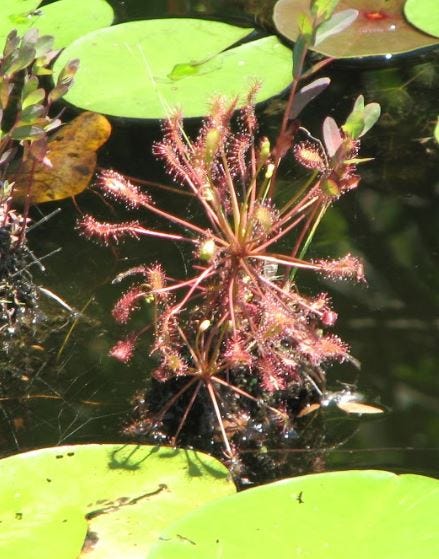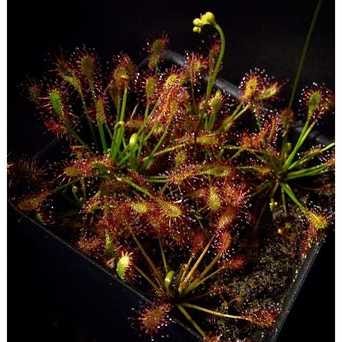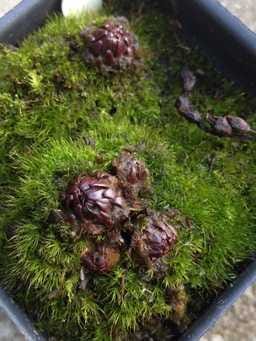GROWING COLD-TEMPERATE DROSERA
Introduction
The most common cold-temperate species in cultivation are D. intermedia, D. rotundifolia, D. filiformis, D. anglica, and associated hybrids. They are typically found in sunny and permanently wet Sphagnum bogs or seeps. Each species has its own areas where it has been recorded, but generally they are found in North America, Europe, Asia, and South America. D. rotundifolia has the largest range of any Drosera species and ranges from Alaska to Pacific North America, Europe, the Kamchatka Peninsula, South Korea, southeast China, Japan and southeast Asia. In 2016, D. rotundifolia was also reported from a highland Sphagnum bog on the island of Mindanao in the Philippines (ironically discovered on an expedition for Nepenthes, HA!), although I don't believe that plants from this location are in cultivation yet.
A Few Notes on Cultivation
The culture of cold-temperate Drosera is much like that of Sarracenia and Dionaea (not surprising, considering they are often found growing sympatrically in the southeastern US). During the growing season, they appreciate being grown in deep trays of water. Plants grown in full sun outside are the healthiest and develop the best coloration. High temperatures up to and even over 100F and low humidity do not faze most of them, as long as they are not allowed to dry out. They do not seem to be very picky regarding moisture levels provided that the crowns of the plants are not submerged for extended periods of time. They perform well in the standard 1:1 peat/sand CP mix but will also grow in pretty much anything provided it is acidic and nutrient-free - plants in situ are often found growing on logs or floating Sphagnum hummocks. Like Dionaea, they are extremely intolerant of nutrients in their soil, and it is recommended to water them only with water below 50ppm or so. As with all Drosera they are appreciative of feeding during active growth, although if you grow them outdoors as recommended this will not be a chore as the plants will catch plenty of prey by themselves.
Dormancy
As temperatures and photoperiod decrease during the fall, the plants' active trapping leaves will die and be replaced by a tight winter resting bud called a hibernaculum. During winter dormancy, the plants should be kept cool to cold (under 50F) and only damp - I have noticed that hibernacula tend to rot if kept saturated during dormancy. If you are expecting cold winds and/or temperatures under 20F, it is best to protect the plants. I keep mine under 2' of pine needle mulch along with my other temperate CPs; the hibernacula have no particular need to photosynthesize during winter. They are tolerant of freezes given that they are not constantly being thawed and refrozen. When the temperature and photoperiod increase in spring, new leaves will emerge from the hibernacula and the plants will resume growth. It is safe to place the plants in their water trays for the growing season once the danger of late frosts has passed.
Propagation
Mature plants will flower copiously during the growing season and spew seed everywhere. The species mentioned above are all capable of breeding amongst themselves and with warm-temperate species like D. capillaris, D. brevifolia, and southern forms of D. filiformis and D. tracyi. To induce germination, the seeds will either need a cool, damp refrigerator stratification period somewhere in the area of 6-8 weeks or be left outside over winter (be warned that if you choose the latter there is a large risk of rain transferring seeds between pots). Seeds should be sown on the surface of the media and not buried.
Some Final Notes
Several species mentioned above have forms native to warmer climates; D. intermedia from Cuba and Roraima State, Brazil, D. anglica from Hawaii, and D. filiformis var. floridana from Florida are some of the more common ones in cultivation. These plants can be grown like subtropicals all year without dormancy and are intolerant of hard freezes. Seeds of these forms do not require stratification and should be treated just like any other subtropical species.
D. linearis is another cold-temperate species native to the Great Lakes Region and southern Canada but is not very common in cultivation. Unlike any other Drosera, it grows primarily in wet alkaline marl fens. Other growers report difficulty with this species and note that it expects to be dormant for the majority of the year, making its cultivation in milder climates a challenge. I do not grow this oddball, nor do I expect to be growing it anytime soon, so this is all I have to say on the matter.





